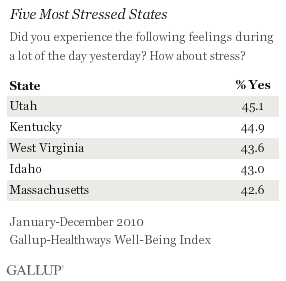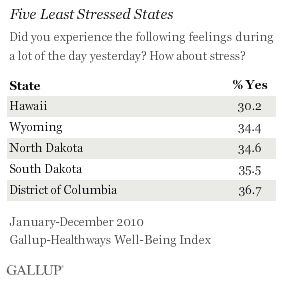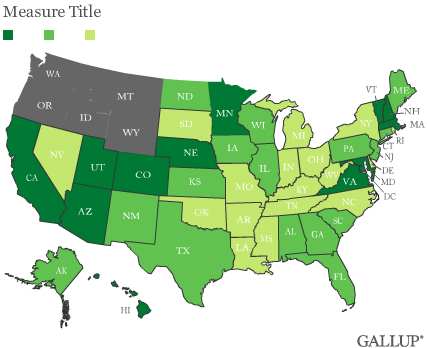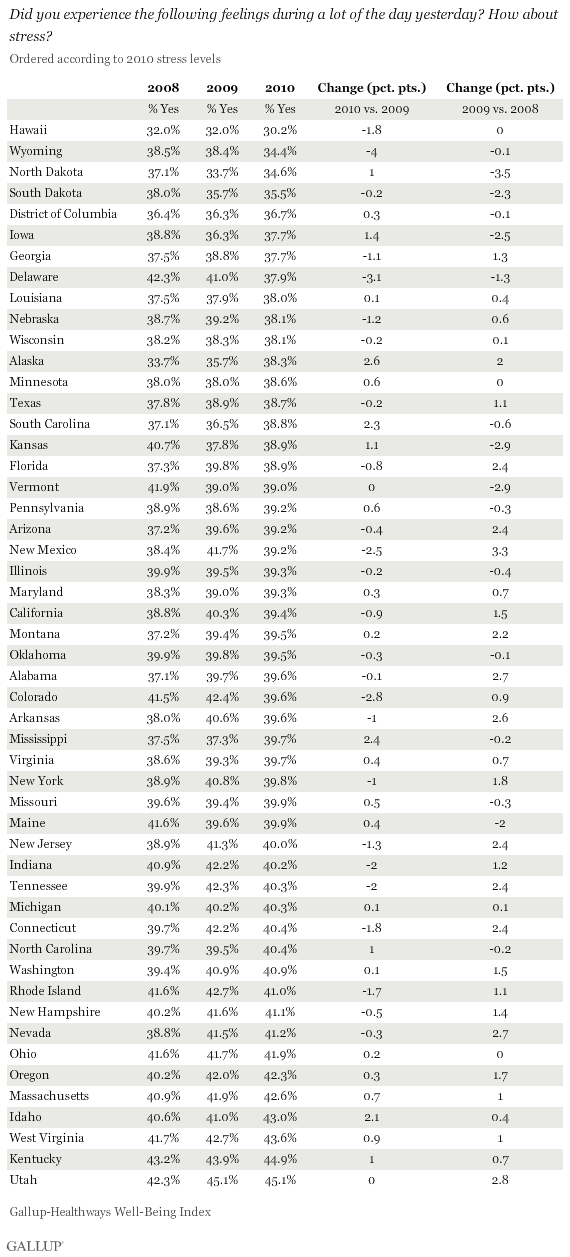WASHINGTON, D.C. -- Hawaii residents were the least likely in the United States in 2010 to say they felt stressed for much of the previous day, at 30.2%. Residents of Utah were the most likely to report experiencing stress, at 45.1%, according to the Gallup-Healthways Well-Being Index.


These state-level data are based on daily surveys conducted from January through December 2010 and encompass more than 350,000 interviews. Americans' average stress level was 39.4% last year, similar to 2009 (39.9%) and 2008 (38.8%).
Hawaii has had the distinction of being the least stressed state for three years in a row. Utah and Kentucky have been among the top two most stressed states for the past three years.
Stress levels decreased at least somewhat for residents living in about half of the states in 2010. This is a positive turnaround from 2009, when residents' stress levels increased in most states. See page 2 for results for all states by year.
Most Stressed Residents Live in the West and Northeast
States with 40% or more people reporting being stressed are mostly clustered in the West and Northeast, but also include Michigan, Ohio, West Virginia, and Kentucky.
States with lower stress levels -- where less than 38% of residents reported experiencing it -- are primarily located in parts of the Midwest.

Bottom Line
The Gallup-Healthways Well-Being Index state data underscore that stress is a complex emotion that is likely related to numerous life issues. States where residents have higher levels of stress differ from each other on various fronts: Some have more high-income residents, while others have more low-income residents. Some, like Utah and Massachusetts, have residents who boast great physical health, while others, like Kentucky and West Virginia, have residents who are in poor health. And in some of the high-stress states residents rate their lives highly -- as in Connecticut, Utah, and Massachusetts -- while in others, residents rate their lives at the lowest end of the scale, as in Ohio and Rhode Island.
That finances and health aren't the only determinants of Americans' stress levels reveals that earning more money or being in great physical shape doesn't necessarily protect against all of life's stressors. Family and career issues likely play a large role in individuals' daily stress levels.
That stress levels did not increase much during the recession provides additional evidence that Americans' definition of stress goes beyond economic experiences. Still, further investigation into what drives stress and how stress affects people is needed as nearly 40% of American adults consistently report experiencing it a lot of the day "yesterday."
Gallup's "State of the States" series reveals state-by-state differences on political, economic, and well-being measures Gallup tracks each day.About the Gallup-Healthways Well-Being Index
The Gallup-Healthways Well-Being Index tracks U.S. and U.K. well-being and provides best-in-class solutions for a healthier world. To learn more, please visit well-beingindex.com.
Survey Methods
Results are based on telephone interviews conducted as part of the Gallup-Healthways Well-Being Index survey Jan. 1-Dec. 31, 2010, with a random sample of 352,840 adults, aged 18 and older, living in all 50 U.S. states and the District of Columbia, selected using random-digit-dial sampling.
For results based on the total sample of national adults, one can say with 95% confidence that the maximum margin of sampling error is ±1 percentage point.
The margin of sampling error for most states is ±1 to ±2 percentage points, but is as high as ±4 points for states with smaller population sizes such as Wyoming, North Dakota, South Dakota, Delaware, and Hawaii.
Interviews are conducted with respondents on landline telephones and cellular phones, with interviews conducted in Spanish for respondents who are primarily Spanish-speaking. Each daily sample includes a minimum quota of 200 cell phone respondents and 800 landline respondents, with additional minimum quotas among landline respondents for gender within region. Landline respondents are chosen at random within each household on the basis of which member had the most recent birthday.
Samples are weighted by gender, age, race, Hispanic ethnicity, education, region, adults in the household, cell phone-only status, cell phone-mostly status, and phone lines. Demographic weighting targets are based on the March 2010 Current Population Survey figures for the aged 18 and older non-institutionalized population living in U.S. telephone households. All reported margins of sampling error include the computed design effects for weighting and sample design.
In addition to sampling error, question wording and practical difficulties in conducting surveys can introduce error or bias into the findings of public opinion polls.
For more details on Gallup's polling methodology, visit www.gallup.com.

